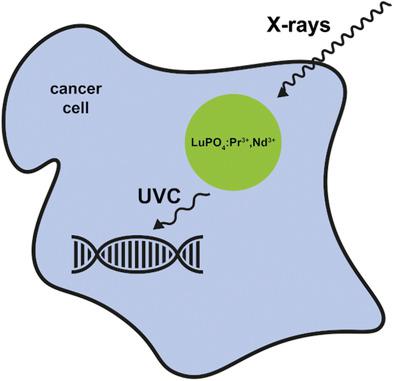当前位置:
X-MOL 学术
›
Part. Part. Syst. Charact.
›
论文详情
Our official English website, www.x-mol.net, welcomes your
feedback! (Note: you will need to create a separate account there.)
Particle Size of X‐ray Pumped UVC‐Emitting Nanoparticles Defines Intracellular Localization and Biological Activity Against Cancer Cells
Particle & Particle Systems Characterization ( IF 2.7 ) Pub Date : 2020-08-18 , DOI: 10.1002/ppsc.202000201 Matthias Müller 1 , Ramtin Rahmanzadeh 2 , Thao Tran 1 , Jan Kappelhoff 3 , Eman Aburieda Akam 4 , Peter Caravan 4 , Thomas Jüstel 3 , Kathryn D. Held 5 , R. Rox Anderson 1 , Martin Purschke 1
Particle & Particle Systems Characterization ( IF 2.7 ) Pub Date : 2020-08-18 , DOI: 10.1002/ppsc.202000201 Matthias Müller 1 , Ramtin Rahmanzadeh 2 , Thao Tran 1 , Jan Kappelhoff 3 , Eman Aburieda Akam 4 , Peter Caravan 4 , Thomas Jüstel 3 , Kathryn D. Held 5 , R. Rox Anderson 1 , Martin Purschke 1
Affiliation

|
Effectiveness of radiation treatment for cancer is limited in hypoxic tumors. Previous data shows that UVC‐emitting nanoparticles enhance cytotoxicity of X‐ray irradiation in hypoxic tumor cells. This study examines the impact on cell killing, particle size, uptake into cells, incubation time, and UV emission intensity of LuPO4:Pr3+,Nd3+. A549 cells are treated with LuPO4:Pr3+,Nd3+ and X‐rays. The surviving fraction is evaluated using the colony formation assay after treatment of cells with different particle sizes (D50 = 0.16 and 5.05 µm) and after different incubation times before X‐ray irradiation. Nanoparticle uptake into cells is verified by transmission electron microscopy and quantified by inductively coupled plasma mass spectrometry. The microparticles exhibit a five times higher emission intensity compared to nanoparticles. Both particle sizes show an increased cytotoxic effect after X‐ray excitation with prolonged incubation times. Surprisingly, the smaller nanoparticles show a significantly higher biological effect compared to the larger particles, despite their significantly lower UVC emission. Nanoparticles accumulate more quickly and closer to the nucleus than the microparticles, resulting in higher localized UVC emission and greater lethality. The results suggest that the number of intracellular particles and their proximity to the cell DNA is more important than the emission intensity of the particles.
中文翻译:

X射线泵浦的发射UVC的纳米粒子的粒径定义了针对癌细胞的细胞内定位和生物活性。
缺氧肿瘤的放射治疗效果有限。先前的数据表明,发射UVC的纳米颗粒增强了低氧肿瘤细胞中X射线辐射的细胞毒性。这项研究研究了LuPO 4:Pr 3+,Nd 3+对细胞杀伤,粒径,摄入细胞,孵育时间和紫外线发射强度的影响。A549细胞用LuPO 4:Pr 3+,Nd 3+和X射线处理。在处理不同粒径的细胞后,使用集落形成测定法评估存活分数(D 50= 0.16和5.05 µm),并且在X射线照射之前经过了不同的孵育时间。纳米颗粒摄入细胞通过透射电子显微镜验证,并通过电感耦合等离子体质谱法定量。微粒的发射强度是纳米颗粒的五倍。X射线激发后,随着孵育时间的延长,两种粒径均显示出增加的细胞毒性作用。出乎意料的是,尽管较大的颗粒具有较低的UVC发射,但与较大的颗粒相比,具有明显更高的生物学效果。纳米粒子比微粒更快地积累并且更靠近核,从而导致更高的局部UVC发射和更大的杀伤力。
更新日期:2020-10-21
中文翻译:

X射线泵浦的发射UVC的纳米粒子的粒径定义了针对癌细胞的细胞内定位和生物活性。
缺氧肿瘤的放射治疗效果有限。先前的数据表明,发射UVC的纳米颗粒增强了低氧肿瘤细胞中X射线辐射的细胞毒性。这项研究研究了LuPO 4:Pr 3+,Nd 3+对细胞杀伤,粒径,摄入细胞,孵育时间和紫外线发射强度的影响。A549细胞用LuPO 4:Pr 3+,Nd 3+和X射线处理。在处理不同粒径的细胞后,使用集落形成测定法评估存活分数(D 50= 0.16和5.05 µm),并且在X射线照射之前经过了不同的孵育时间。纳米颗粒摄入细胞通过透射电子显微镜验证,并通过电感耦合等离子体质谱法定量。微粒的发射强度是纳米颗粒的五倍。X射线激发后,随着孵育时间的延长,两种粒径均显示出增加的细胞毒性作用。出乎意料的是,尽管较大的颗粒具有较低的UVC发射,但与较大的颗粒相比,具有明显更高的生物学效果。纳米粒子比微粒更快地积累并且更靠近核,从而导致更高的局部UVC发射和更大的杀伤力。











































 京公网安备 11010802027423号
京公网安备 11010802027423号